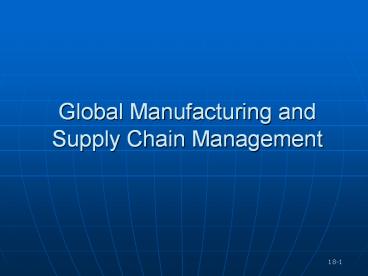Global Manufacturing and Supply Chain Management - PowerPoint PPT Presentation
Title:
Global Manufacturing and Supply Chain Management
Description:
* * * * * * * * * * * * * * * * * * * * * Strategy, Production, ... International Business Author: Greg Bier Last modified by: Razuan Created Date: 1/6/2003 10:19:23 PM – PowerPoint PPT presentation
Number of Views:920
Avg rating:3.0/5.0
Title: Global Manufacturing and Supply Chain Management
1
Global Manufacturing and Supply Chain Management
18-1
2
Strategy, Production, and Logistics
- Production is the activities involved in creating
a product - Can be both service and manufacturing activities
- Logistics is the activity that controls the
transmission of physical materials through the
value chain - Production and logistics are closely linked since
a firms ability to perform its production
activities efficiently depends on a timely supply
of high quality material inputs
3
Strategy, Production, and Logistics
- Production and logistics functions have a number
of important strategic objectives - Lower costs
- Increase product quality by eliminating defective
products from both the supply chain and the
manufacturing process - These objectives are interrelated
- Increasing productivity because time is not
wasted producing poor-quality products that
cannot be sold, leading to a direct reduction in
unit costs - Lowering rework and scrap costs associated with
defective products - Reducing the warranty costs and time associated
with fixing defective products
4
Production Strategy
Production operations are essential to achieve
objectives
5
Capacity Planning
Assessing a companys ability to produce enough
output to satisfy market demand
- Number of work shifts
- Number of employees
- Size of facilities
- Subcontracting
6
Facilities Location Planning
Selecting the location for production facilities
Location economies
Centralized
Decentralized
Economic benefits derived from locating production
activities in optimal locations (generates more
value)
Centralized production tends to be well-suited to
global strategy
Decentralized production tends to be
well-suited to multinational strategy
7
Process Planning
- Standardization
- Suits low-cost leadership
- More automated (EOS)
- Adaptation
- Suits differentiation and focus
8
Facilities Layout Planning
Deciding the spatial arrangement of production
processes within facilities
9
Supply Chain Terms
- Supply chains the coordination of materials,
information, and funds from the initial raw
material supplier to the ultimate customer - Logistics (materials management) that part of
the supply chain process that plans, implements,
and controls the efficient, effective flow and
storage of goods, services, and related
information
18-3
10
Factors Managers Must Consider
- Efficiency/cost-reduction of manufacturing costs
- Dependability-degree of trust in a companys
products and its delivery and promises - Innovation-ability to develop new products and
ideas
18-5
11
Factors ManagersMust Consider, cont
- Quality-performance reliability, service quality,
speed of delivery, and maintenance quality of the
product - Flexibility-ability of the production process to
make different kinds of products and to adjust
the volume of output
18-6
12
Manufacturing Configurations
- Centralized manufacturing offering a selection of
standard, lower-priced products to different
markets - Regional manufacturing to serve customers within
a specific region - Multi-domestic manufacturing (market expansion)
in individual countries as their demand becomes
significant so manufacturing is closer to
customers and meeting local needs
18-7
13
Supplier Networks Acquiring Physical Resources
- Companies can manufacture parts internally or
purchase them from external manufacturers - make or buy decision
- Outsourcing is the process of a company having
inputs supplied to it from outside suppliers for
the production process
18-13
14
Decision to Make
Vertical integration Extend control over inputs
(backward integration) or output (forward
integration)
15
Decision to Buy
Reasons to buy
Outsourcing
Buying from another company a good or service
that is not central to a companys competitive
advantage
Lower risk
Greater flexibility
Market power
Barriers to buying
16
18-14
17
Global Component Network
18-15
18
Advantages of Global Sourcing
- Reduce costs due to less expensive labor
- Improve quality
- Increase exposure to worldwide technology
- Improve delivery of supplies
- Strengthen reliability of supply by supplementing
domestic with foreign suppliers - Gain access to materials available only abroad
- Establish presence in a foreign market
- Satisfy offset requirements
- React to competitors offshore sourcing problems
18-16
19
Phases of Global Purchasing
- Domestic purchasing only
- Foreign buying based on need
- Foreign buying as part of procurement strategy
- Integration of global procurement strategy
18-17
20
(No Transcript)
21
Quality
- Quality is the ability to meet or exceed the
expectations of the customer - Conformance to specifications
- Value
- Fitness for use
- Support provided by the company
- Psychological impressions (image)
18-9
22
Quality Improvement
Total Quality Management (TQM)
ISO 9000
Continuous quality improvement to meet or exceed
customer expectations through quality-enhancing
processes
International Standards Organization 9000 is
a certification a firm gets when it meets the
highest quality standards in its industry
23
Levels of Quality Standards
- General level
- ISO 9000
- Malcolm Baldridge National Quality Award
- Industry-specific level
- Company level
18-11
24
Other Production Issues
25
Decision to Reinvest or Divest
Reinvest
Divest
- Promising outlook
- Growing market
- Highest return
- Unprofitable outlook
- Social unrest
26
Financing Business Operations
- Borrowing
- Take advantage of interest rates variation across
countries - back-to-back loan
- Issuing equity
- Selling stocks to raise capital
- Internal funding
- Swapping debt or equity
- Charging for royalties and licensing fees































